Labels for Safety, Visuals and Facility ID Desktop Printers
Labels for Product, Wire and Lab ID Benchtop Printers
Labels for Safety, Visuals and Facility ID Desktop Printers
Labels for Product, Wire and Lab ID Benchtop Printers
Safety and Facility ID Desktop Printers
Product, Wire and Lab ID Benchtop Printers
Barcode Scanners and RFID Readers
PaintStripe Floor Marking Stencils
Valve Lockouts & Hose Lockouts
Group Lock Boxes & Permit Control
Pipe Marker Accessories & Mounting Brackets
Maintenance and Production Tags
Calculators and Assessment Tools
Product Finders and Data Sheets
Labels play a crucial role in a wide variety of industrial, production and laboratory settings, serving as vital communication tools that convey essential information. From saving lives and protecting data to cutting costs and eliminating inefficiencies, labels serve as informative identifiers, guides and instructors. But what goes into a label is just as important as what it goes onto – from the adhesive to the material to the finish and more. This label guide serves as an indispensable resource for making informed decisions in understanding, choosing and applying labels.
From cost-effective paper labels for indoor use to durable polyester labels for outdoor settings, label material sets the stage for performance, durability, ideal use and more.
Paper labels are versatile and commonly used for general purpose identification and barcode labeling. Made from paper materials, these labels are cost-effective and suitable for indoor applications.
Polyester labels are made from a synthetic material and offer a durable and versatile solution for applications requiring resistance to moisture and chemicals. Commonly used in product labeling and outdoor settings, polyester labels are known for their excellent printability and clarity.
Polyethylene labels are made from a durable plastic material and are ideal for applications requiring resistance to water and outdoor exposure. These labels find use in various industries, such as logistics and outdoor equipment labeling. With strong adhesive properties, polyethylene labels adhere well to different surfaces.
Polyimide labels, known for their high-temperature resistance and durability, are commonly used in industries such as electronics and aerospace. These labels withstand harsh environments and extreme temperatures, making them suitable for applications that demand reliability and longevity. Polyimide labels often find use in product identification and circuit board labeling.
Polypropylene labels offer a balance of durability and cost-effectiveness. Widely used in product labeling and packaging, polypropylene labels resist water and chemicals. They are available in various forms, such as clear or white, making them versatile for different applications. These labels are compatible with various printing methods.
Metallized polyester labels combine the durability of polyester with a metallic finish, providing an aesthetically appealing option for applications like identification labels or rating and serial plates that utilize barcodes, alphanumerics, graphic symbols and logos and require nameplate-like quality. These labels offer resistance to outdoor elements and chemicals.
Vinyl labels, made from a durable plastic material, are known for their flexibility and resistance to moisture. Commonly used for outdoor signage, safety labels and branding, vinyl labels adhere well to curved surfaces.
Polyolefin labels are versatile, cost-effective labels suitable for wire marking in indoor applications. With good printability, extreme temperature resistance and durability against fading and abrasions, these labels find use in wire identification and insulation purposes.
Nylon labels offer high adhesion and high pliability to meet a broad array of identification requirements from control panels to liquid nitrogen environments. They conform tightly to curved, rough or irregular surfaces such as wires and cables, stainless steel, textured ABS, polypropylene and many other material types.
Nomex labels are designed for high-temperature environments, such as those found in aerospace and industrial settings. Made from a heat-resistant material, these labels provide durability and reliability in extreme conditions. Nomex labels are commonly used for product identification and safety labeling.
Polycarbonate labels offer a durable solution with excellent impact resistance. Commonly used in industries requiring robust labels, such as automotive and equipment manufacturing, polycarbonate labels withstand harsh conditions. They are known for their clarity, making them suitable for applications where visibility of information is crucial.
Polyurethane labels are known for their flexibility and resistance to chemicals, making them suitable for applications in harsh environments. Used in industrial settings for equipment labeling and product identification, polyurethane labels maintain their quality and readability over time. They are often chosen for their durability and resistance to abrasion.
Polyvinyl fluoride labels, known for their resistance to chemicals and harsh weather conditions, are commonly used in outdoor applications. These labels offer durability and printability, making them suitable for product identification and signage where long-term performance is required.
Polyvinylidene fluoride labels provide excellent chemical resistance and durability in extreme environments. Widely used in industries such as chemical processing and electronics, these labels withstand harsh conditions and maintain their integrity. Polyvinylidene fluoride labels are often chosen for their reliability and resistance to UV radiation.
Labels are applied or displayed in a wide variety of ways - from simple peel and press to sleeves that shrink and adhere to a surface with heat. Here are some of the most common ways labels are applied.
Pressure-sensitive labels, also known as adhesive labels, feature a layer of adhesive on one side that adheres to surfaces upon the application of pressure. These labels are versatile and easy to apply, making them suitable for a wide range of applications. Pressure-sensitive labels are commonly used in product labeling, packaging, and logistics due to their convenience and ability to adhere to various materials.
Self-laminating (self-lam) labels consist of a clear protective layer that can be applied over printed information to create a laminated effect. These labels are designed to protect printed content from elements such as water, oil, and abrasion. Self-laminating labels are often used in industrial settings for equipment labeling, cable marking, and identification tags where durability and information preservation are essential.
Sleeve labels, also known as shrink sleeves, are applied by sliding a pre-printed plastic sleeve over the container, which is then heat-shrunk to conform tightly to the shape of the item. This method allows for full-color printing and 360-degree coverage of the surface. Sleeve labels are popular in wire marking and cable identification, providing a more effective and longer-lasting solution
Tags are labels typically made of paper or cardstock that are attached to items using strings, wires or adhesive. Tags are commonly used for safety identification, lockout tagout operations and valve ID. They can be easily attached and removed for temporary labeling needs. Tags can be customized with printed information, barcodes and branding elements such as photos or logos.
Labels offer a range of specialized properties to meet diverse needs. From temperature-related features to chemical resistance, these properties contribute to the adaptability, functionality and visual appeal of labels in various applications.
Labels with temperature-related properties are designed to withstand specific temperature conditions, catering to diverse environments and applications.
Labels with environmental considerations are tailored to perform optimally in different settings, addressing the challenges posed by varying conditions.
Labels with chemical-resistant properties are crucial in environments where exposure to various chemicals is a concern, ensuring that the label remains intact and legible despite contact with different substances.
Tamper-evident labels are designed to reveal evidence of tampering, ensuring the integrity of sealed products or packages. These labels fracture or leave a visible mark when tampered with, serving as a visual indicator of potential interference.
Water-soluble or dissolvable labels are crafted to break down upon contact with water, making them ideal for applications where temporary labeling or easy removal is required, such as in laboratories and temporary asset tracking in manufacturing environments.
Water-indicating labels provide visual cues or irreversible changes when exposed to water, aiding in monitoring environmental conditions or detecting water damage.
Metallic labels offer a lustrous and eye-catching appearance, enhancing product branding and luxury packaging. These labels often use materials like foil or metalized finishes to create a visually striking and premium effect.
Adhesive types play a crucial role in determining the performance and application of labels. The choice between acrylic and rubber-based adhesives depends on the specific requirements of the application, such as permanence, repositionability and environmental factors.

Acrylic-based adhesives are known for their versatility and durability. Acrylic-based adhesives are commonly used in various label applications due to their excellent adhesion to different surfaces and resistance to temperature changes.
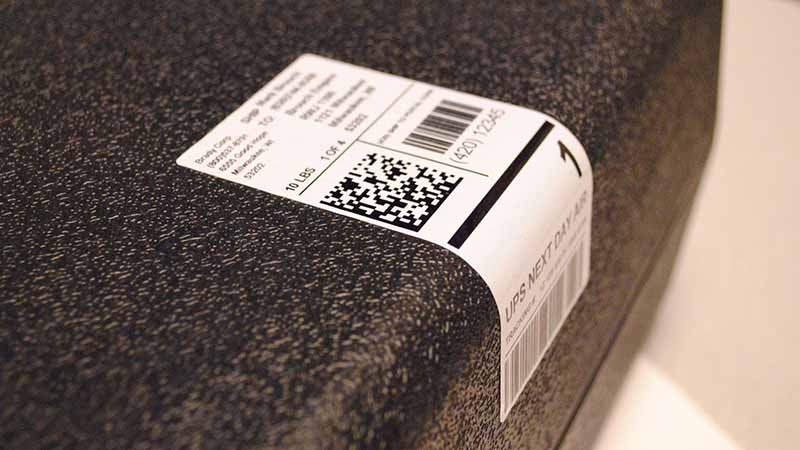
Rubber-based adhesives, generally, are lower cost, provide good initial tack and have more flexibility compared to acrylic-based adhesives. This often makes them ideal for repositionable labeling. Though, depending on the application, this adhesive can be built specifically to offer as much or even more adhesion than acrylic.
Label adhesives are composed of a carefully engineered set of traits to adapt to various conditions, applications and needs. These include adhesive strength, resistance to elements and temperature handling. Depending on the combination, label adhesives can be grouped by property. Here are some of the most common label adhesive properties.
Permanent adhesives are the preferred choice for labeling solutions that require durability in challenging conditions. Known for their resilience, these adhesives create a strong and enduring bond with surfaces. Notably resistant to various elements, including chemicals, water and solvents, permanent adhesives maintain their integrity even with repeated exposure. Their versatility extends to weathering extreme temperatures, encompassing both high and low ranges, as well as cryogenic settings. Particularly well-suited for harsh outdoor environments and industrial settings like the food and beverage industry, permanent adhesive labels excel in scenarios involving moisture, UV rays, wind and washdown procedures.
Removable adhesive labels strike a balance between secure adhesion and easy removal, catering to areas requiring temporary labeling and frequent changes. Engineered for a secure bond with surfaces, these labels allow for clean and residue-free removal. While not as resistant as permanent adhesive labels to harsh environmental factors, removable adhesive offers moderate resistance to chemicals and water. Primarily designed for standard temperature environments, it may not perform optimally in extreme conditions. Removable adhesive is well-suited for less harsh, stable indoor environments, particularly in scenarios where labeling changes are frequent or a short label lifespan is needed. It finds application in alphanumeric and barcode tasks in electronic component marking, as well as in retail pricing, shelving and Lean/5S labeling.
Repositionable adhesive strikes a balance between convenience and durability, allowing for multiple reapplications without compromising bonding capabilities. The adhesive formulation of repositionable adhesive labels enables them to be reapplied several times with minimal loss to adhesion strength. Suitable for indoor environments or semi-protected outdoor settings with occasional exposure to mild chemicals or moisture, repositionable adhesive provides versatility. Designed for standard temperature ranges, it may not be the optimal choice for applications subjected to extreme temperatures or cryogenic settings. Ideally suited for indoor environments requiring flexibility in label placement, repositionable adhesive is commonly used in bin labeling, shelving, and Lean/5S applications.
Temperature-specific adhesives are essential tools in industries where temperature extremes are a daily occurrence. Engineered to perform optimally within designated temperature ranges, high-temperature labels endure extreme heat without losing adhesion or legibility, while low-temperature labels remain effective in deep freezes. Cryogenic labels are crucial for ultra-low-temperature storage environments, maintaining integrity and adhesion in extreme cold. These labels are indispensable in applications where temperature extremes are constant, such as industrial processes with extreme heat, high-altitude flight in aerospace and aviation, and laboratories relying on cryogenic adhesive labels for ultra-low-temperature freezers.
Labels are used wherever information needs to be conveyed. Here are a few of the most common applications where you’ll find labels.
Circuit board labeling is crucial for identifying components and other relevant information on electronic circuit boards. Circuit board labels use polyimide material due to its durability and resistance to high temperatures. These labels can be applied using pressure-sensitive adhesives or as self-laminating options, ensuring clear identification even in challenging environments.

Data communication (DataCom) labeling involves the labeling of network cables, connectors and equipment in information technology and telecommunications settings. DataCom labels are commonly made from polyester or polyethylene, offering durability and resistance to environmental factors. Pressure-sensitive labels are frequently used in DataCom for their ease of application and versatility in various networking environments.

Electrical labeling involves marking components, wires and panels in electrical systems. Electrical labels often use materials like polyolefin or vinyl for their durability and resistance to electrical currents. These labels can be applied using pressure-sensitive adhesives or as self-laminating options, ensuring clear and long-lasting identification in electrical installations.

General identification labels are used for a variety of applications where clear and concise labeling is needed for general items, equipment or assets. Common label materials include paper, polyester or polypropylene, depending on the application requirements. These labels are often pressure-sensitive and can be easily customized for different identification needs.
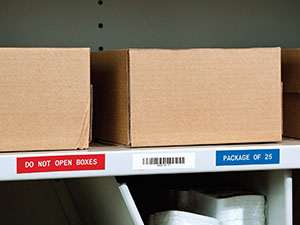
Labels for inspection and repair applications are used to mark equipment, tools or machinery with important information. Durable materials like polyester or polypropylene are commonly employed to withstand the rigors of industrial environments. Inspection labels are often applied using pressure-sensitive adhesives for easy and quick marking.
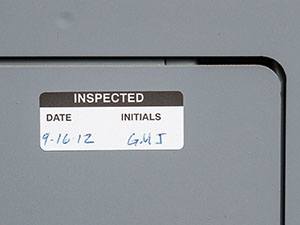
Laboratory labeling is essential for identifying samples, containers and equipment in scientific settings. Laboratory labels often use materials like polypropylene or polyethylene, chosen for their resistance to chemicals and environmental conditions. Pressure-sensitive labels are commonly used in laboratories for their ease of application and customization to specific research needs.

Rating and name plates involve labeling equipment with essential information such as specifications, ratings, and identification details. Materials like polycarbonate or aluminum are commonly used for their durability and resistance to outdoor conditions. These labels are often attached using adhesive backing or as rigid nameplates with mounting holes.
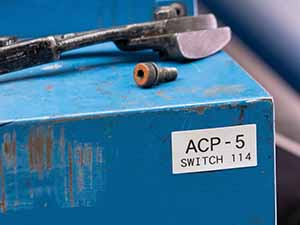
Safety labels are critical for conveying warnings, instructions, or important safety information in workplaces. Safety labels can be made from materials like vinyl or polyester for durability and visibility. Pressure-sensitive labels are commonly used for safety applications, ensuring that the labels adhere securely to surfaces in various environments.
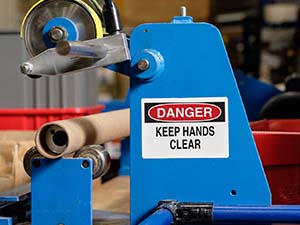
Wire and cable labeling is essential for organizing and identifying electrical and data cables. Wire and cable labels often use materials like polyolefin or polyester due to their flexibility and resistance to environmental factors. These labels are frequently applied using pressure-sensitive adhesives or heat-shrink sleeves for a secure and long-lasting attachment.
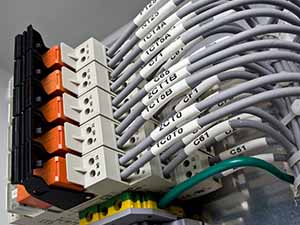
Regulations may require specific information, certifications or marks to be displayed on products. They may also dictate compliance with safety, environmental or performance standards. Here are a few of the most common regulations.
CSA is a Canadian organization that develops and publishes standards for a variety of industries to ensure the safety and performance of products. Products that comply with CSA standards often require labeling to indicate certification. Labels may include CSA marks to demonstrate adherence to safety and performance criteria, providing assurance to consumers and regulatory authorities in Canada.
cUL certification is a safety standard for electrical and electronic products in Canada. Issued by Underwriters Laboratories Canada, this certification ensures that products comply with specific safety requirements. Labels bearing the cUL mark signify that the product has undergone testing and meets the necessary safety standards. The label serves as a visual indicator of compliance, promoting consumer confidence and regulatory adherence.
RoHS is a European Union directive that restricts the use of specific hazardous substances in electronic and electrical equipment. Products complying with RoHS standards are labeled to indicate that they are free from substances like lead, mercury, cadmium and others. RoHS labels help consumers identify environmentally friendly products and demonstrate compliance with European regulations.
UL is a global safety certification organization that establishes standards for various product categories, focusing on safety and performance. Products that meet UL standards receive certification, and labels with the UL mark indicate compliance. UL labels are crucial for products entering markets like the United States, as they assure consumers and regulatory authorities of adherence to safety and performance requirements.
Label finishes play a crucial role in determining the visual appeal and functionality of printed labels and help ensure they’re suitable for specific industries and applications.
A gloss finish adds a shiny and reflective surface to a label, providing a vibrant and polished appearance. Glossy labels are visually striking, with a reflective quality that enhances color vibrancy.
A matte finish provides a non-reflective, smooth surface to labels. Matte labels are commonly used when effective color contrast is needed under varying light conditions.
Labels with no finish have a natural, untreated appearance. They lack additional coatings or textures, providing a straightforward look.
A satin finish falls between gloss and matte, offering a subtle sheen without the high reflectivity of gloss.
A semi-gloss finish combines aspects of gloss and matte, providing a moderate level of reflectivity.
Reflective or retro-reflective finishes are designed to reflect light back towards its source, enhancing visibility in low-light conditions.
Glow-in-the-dark finishes absorb and store light energy, then emit it gradually in the dark, creating a luminous effect.
Having the wrong label could lead to disasters in your identification task including wasted time doing re-work, errors in your processes and unhappy customers. The following examples explain what could go wrong if you use the wrong type of label for your application:
You need your labels to keep a crisp and legible legend for effective identification. Using the wrong label could lead to smearing, fading and unreadable text. With the right label, you benefit from durable ink formulas, protective coating options that stand up to your application needs, and legible messages with high-resolution printing and a variety of font sizes.

When your label doesn’t have the correct topcoat for your identification task, the topcoat could peel off the film, leaving the text and label surface unprotected from the elements. The right label topcoat withstands the temperatures, chemicals and other environmental elements in your application.

Using a label with a film that cannot stand up to the high heat you may have in your applications could lead to shrinking or discoloration. Find a durable material that aligns with the environmental challenges your application demands to ensure your label stays intact.

Adhesive is an essential element when it comes to effective identification. The adhesive means your label could lift, fall off, move around or leave residue. Whether acrylic or rubber adhesive, permanent or removable, be sure to find the right adhesive that adheres to the surfaces you require for the duration of your identification project.

| Label type | Properties | Adhesive function | Adhesive type | Compliance | Finish | Popular applications | Popular industries | Popular B#s | |
|---|---|---|---|---|---|---|---|---|---|
| Paper |
|
|
|
|
N/A |
|
|
|
|
| Polyester |
|
|
|
|
|
|
|
|
|
| Polyethylene | Tags |
|
N/A | N/A | N/A | Matte |
|
Manufacturing | B-109 |
| Polyimide |
|
|
|
Acrylic |
|
Matte |
|
|
|
| Polypropylene | Pressure sensitive |
|
|
Acrylic |
|
Matte |
|
|
|
| Metallized polyester | Pressure sensitive |
|
|
Acrylic |
|
|
|
|
|
| Vinyl |
|
|
|
Acrylic | RoHS compliant to 2011/65/EU (Pass 2015/863) |
|
|
|
|
| Polyolefin | Heat shrink |
|
|
N/A |
|
Matte |
|
|
|
| Nylon |
|
|
|
Acrylic |
|
Matte |
|
|
B-499 |

A comprehensive guide to label adhesive types, properties, and applications.
Explore the essential guide on label adhesives
A guide to understanding different label printer types including thermal, Inkjet and direct thermal
Discover the difference in printers
our guide to the advantages of on-demand versus preprinted labels to suit your operational requirements
Compare: preprinted or on-demand labels?